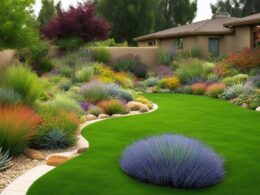Xeriscaping is a sustainable landscaping practice that focuses on water conservation and promoting biodiversity. It involves using drought-tolerant plants, efficient irrigation techniques, and proper soil management. By prioritizing low-water plants and native species, xeriscaping can help reduce water usage, support local ecosystems, and create beautiful, eco-friendly gardens.
Key Takeaways:
- Xeriscaping is a sustainable landscaping practice that prioritizes water conservation and biodiversity.
- It involves using drought-tolerant plants, efficient irrigation systems, and proper soil management.
- Xeriscaping can help reduce water usage, support local ecosystems, and create beautiful, eco-friendly gardens.
- By incorporating native species and low-water plants, xeriscaping promotes biodiversity and reduces the need for excessive watering.
- Proper planning, zoning, and maintenance are crucial for the success of a xeriscape garden.
The Principles of Xeriscaping
Xeriscaping, also known as sustainable landscaping, is a method that not only conserves water but also promotes biodiversity in outdoor spaces. By following a set of key principles, you can create an eco-friendly and visually appealing landscape that minimizes water usage and fosters a thriving ecosystem.
Principle 1: Suitable Planning and Design
Proper planning and design are crucial in xeriscaping. Consider factors such as sun exposure, soil conditions, and your region’s climate to determine the best layout for your garden. By strategically placing drought-tolerant plants and grouping them based on their water needs, you can optimize water usage and create functional and attractive outdoor spaces.
Principle 2: Practical Lawn Areas
Rethink the traditional concept of a lush green lawn and consider reducing its size or replacing it with alternatives that require less water. Incorporate native grasses or ground covers that are well-suited to your region to minimize water requirements and maintenance while still providing a visually appealing element to your landscape.
Principle 3: Efficient Irrigation
Efficient irrigation is essential in xeriscaping. Choose water-saving techniques such as drip irrigation, which delivers water directly to the plant roots, minimizing evaporation and runoff. Install a rain sensor or a smart irrigation controller to optimize watering schedules based on weather conditions, ensuring that water is used only when necessary.
Principle 4: Soil Protection and Improvements
Protecting and improving the soil in your landscape is key to maximizing water absorption and promoting plant health. Apply organic mulch, such as wood chips or shredded bark, to retain soil moisture, prevent weed growth, and improve soil structure. Additionally, consider adding organic matter, like compost, to enhance the soil’s water-holding capacity and nutrient content.
Xeriscape Design: Creating a Water-Conscious Layout with Indigenous Plants
When it comes to xeriscaping, proper design and zoning are key to creating a beautiful and water-conscious landscape. By carefully planning and considering various factors, such as existing plants, sun exposure, and water requirements, you can optimize water usage and promote biodiversity in your outdoor space.
Start by evaluating your outdoor area and identifying any existing plants that can be incorporated into your xeriscape design. This helps maintain a sense of continuity while also minimizing the need for additional water. Consider the sun exposure of different areas in your garden and design accordingly, grouping plants with similar light requirements together.
One of the central principles of xeriscaping is using indigenous plants that are adapted to the local climate and soil conditions. These plants are naturally drought-tolerant and require less water compared to non-native species. By incorporating a variety of indigenous plants into your design, you not only conserve water but also support local ecosystems and promote biodiversity.
Creating Zones for Drought-Tolerant Plant Species
A well-designed xeriscape incorporates different zones that cater to the water needs of various plant species. By grouping plants with similar water requirements together, you can efficiently manage irrigation and minimize water waste. For example, you can have a low-water zone with drought-tolerant plants that require minimal irrigation, and a higher-water zone with plants that need more frequent watering.
Creating a visually appealing and water-conscious layout involves using different textures, colors, and heights to add interest to your xeriscape. Consider incorporating gravel, rocks, or hardscape elements to break up the space and provide a sense of structure. These elements not only add aesthetic appeal but also help with water drainage and conservation.
By carefully planning your xeriscape design and incorporating indigenous plants, you can create a beautiful and sustainable outdoor space that conserves water and promotes biodiversity. The next section will focus on efficient irrigation techniques and soil improvement methods that further enhance the water-saving benefits of xeriscaping.
Efficient Irrigation and Soil Improvement
In xeriscaping, efficient irrigation techniques and soil improvement play a crucial role in conserving water and promoting the health of your plants. By implementing these strategies, you can reduce water waste and create a sustainable, thriving garden.
Efficient Irrigation
One of the key water-saving techniques in xeriscaping is the use of efficient irrigation systems. Drip irrigation and soaker hoses are highly recommended for delivering water directly to the plant roots, minimizing evaporation and runoff. These systems provide targeted and consistent water distribution, ensuring that your plants receive the right amount of moisture without wastage.
“Efficient irrigation not only saves water but also helps prevent weed growth and disease, as the foliage of the plants remains dry.”
Additionally, regular monitoring and adjustment of your irrigation system is essential to ensure optimal water usage. By evaluating the specific water needs of different plant species and adjusting the watering schedule accordingly, you can avoid overwatering and underwatering, promoting the health and longevity of your plants.
Soil Improvement
Another important aspect of xeriscaping is soil improvement. By amending the soil with organic matter, such as compost or well-rotted manure, you can enhance its water-holding capacity and fertility. This helps retain moisture around plant roots, reducing the frequency of watering and improving overall water efficiency.
In addition to organic matter, using mulch on the soil surface provides multiple benefits. Organic mulches, such as wood chips or shredded bark, help regulate soil temperature, reduce evaporation, and suppress weed growth. By creating a protective layer over the soil, mulching conserves moisture and improves water retention, allowing your plants to thrive even during dry periods.
Implementing efficient irrigation techniques and improving your soil quality are essential steps in creating a successful xeriscape garden. By optimizing water usage and supporting the health of your plants, you can enjoy a beautiful, sustainable outdoor space while conserving precious water resources.
How Can Xeriscaping Promote Biodiversity and Water Conservation?
Xeriscaping with biodiversity-friendly wildflowers promotes water conservation by reducing the need for irrigation. These native plants also support local ecosystems and attract diverse pollinators, contributing to the overall health of the environment. Embracing xeriscape-friendly practices can help preserve water while adding beauty and diversity to the landscape.
Starting and Maintaining a Xeriscape Garden
Creating a xeriscape garden is an excellent way to conserve water and create a beautiful, sustainable outdoor space. Whether you’re starting from scratch or converting an existing garden, careful planning and maintenance are key to its success. Here are some essential tips to help you get started and maintain a thriving xeriscape garden.
Research Native Plants
When choosing plants for your xeriscape garden, focus on native species that are naturally adapted to the local climate and soil conditions. Native plants are more likely to thrive with minimal water use and require less maintenance overall. Research which plants are native to your region and select those that suit your desired aesthetics and preferences. By incorporating native plants, you’ll also be supporting local ecosystems and promoting biodiversity.
Design Your Garden Layout Strategically
Take time to plan the layout of your xeriscape garden. Consider the water needs of different plant species and group them accordingly. Plants with similar water requirements should be placed together, so you can efficiently water them without wasting water on plants that don’t need as much moisture. Creating distinct zones within your garden can also help maximize water usage and ensure that each area receives the right amount of irrigation.
Regular Maintenance is Essential
Proper maintenance is crucial for the health and longevity of your xeriscape garden. Regularly monitor your plants for signs of pests, disease, or nutrient deficiencies. Implement pest control measures as needed, such as using organic insecticides or practicing integrated pest management techniques. Prune your plants to remove dead or diseased branches and to promote healthy growth. Additionally, adjust your irrigation system periodically to account for seasonal changes and ensure efficient water delivery.
Conclusion
Xeriscaping offers a multitude of benefits that contribute to sustainable landscaping and water conservation. By adopting xeriscaping principles and incorporating drought-tolerant plants, efficient irrigation techniques, and soil improvements, you can make a positive impact on the environment while creating visually stunning gardens.
One of the key advantages of xeriscaping is water conservation. By using low-water plants and implementing targeted irrigation methods such as drip systems, you can significantly reduce water usage in your outdoor space. This not only helps to conserve water resources but also lowers your water bills in the long run.
Another benefit of xeriscaping is the promotion of biodiversity. By selecting indigenous plant species adapted to the local climate and soil conditions, you create habitats for native wildlife, including birds, butterflies, and beneficial insects. Xeriscaping encourages a healthy and balanced ecosystem, fostering the preservation of local plant and animal species.
Furthermore, xeriscaping provides aesthetic appeal. With careful planning and design, your xeriscape garden can be a beautiful and captivating outdoor space. The use of colorful and diverse plant species, combined with well-arranged zones, adds visual interest and creates a unique landscape that is both sustainable and visually pleasing.









